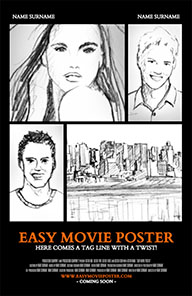Reel Vision: Unleashing Creativity with AI-Powered Movie Poster Generation
Reel Vision: Unleashing Creativity with AI-Powered Movie Poster Generation
Blog Article

In the rapidly evolving landscape of digital art and media, artificial intelligence is emerging as a powerful ally for creators across various fields. One of the most exciting applications of AI is in the realm of movie poster generation. Imagine harnessing the capability of advanced algorithms to design eye-catching promotional material that captures the essence of a film. This innovation not only streamlines the creative process but also opens up a world of possibilities for filmmakers and marketers alike.
With the help of AI movie poster generators, even those without extensive design skills can create stunning visuals that draw in audiences. These tools leverage sophisticated machine learning techniques to analyze existing images, styles, and trends, allowing them to produce unique and engaging artwork. As a result, filmmakers can focus more on their storytelling while relying on AI to visualize their concepts effectively. This blend of creativity and technology is truly revolutionizing the way we think about movie marketing.
Instant movie poster templates
Understanding AI Movie Poster Generation
AI movie poster generation represents a fusion of creative artistry and cutting-edge technology. By leveraging machine learning algorithms and vast datasets, these systems analyze existing movie posters, identifying patterns in design elements such as color schemes, typography, and imagery. This analysis allows AI to create new posters that can capture the essence of a film while appealing to potential audiences. The ability to generate unique and engaging visuals at a rapid pace makes this technology invaluable to filmmakers and marketers alike.
One of the most compelling aspects of AI movie poster generation is its capacity for customization. Filmmakers can input specific themes, genres, or character traits, allowing the AI to tailor its creations to fit the narrative of the project. This level of adaptability not only streamlines the creative process but also provides filmmakers with a diverse range of visual concepts to choose from. Consequently, AI-generated posters can resonate well with target demographics, enhancing marketing effectiveness in a competitive landscape.
Moreover, the introduction of AI in the poster design process fosters collaboration between humans and machines. Creatives can use AI-generated designs as starting points, refining and building upon these suggestions to develop a final product that reflects their vision. This partnership highlights the synergistic potential of technology and creativity, enabling artists to explore new horizons in visual storytelling. As AI continues to evolve, the possibilities for innovative and captivating movie posters seem boundless.
Key Features of AI Tools
AI movie poster generators offer a range of innovative features that empower creators to bring their visions to life. One of the standout capabilities is the intuitive design interface that allows users to input their unique artistic preferences. This user-friendly experience simplifies the creative process, enabling anyone, regardless of their design expertise, to create stunning movie posters in just a few clicks. By leveraging advanced algorithms, these tools can suggest layouts, color schemes, and typographic styles that align with contemporary design trends.
Another significant feature is the ability to customize and personalize designs to fit the unique identity of the film. With options to adjust elements like imagery, fonts, and graphic components, creators can ensure that the final product reflects the essence of their story. AI technology enhances this process by analyzing references and trends, allowing users to explore various aesthetics and create posters that resonate with their target audience. This level of customization transforms each project into a distinctive piece of art.
Moreover, AI-powered movie poster generators enable rapid production and iteration, which is invaluable in the fast-paced world of film marketing. Users can experiment with multiple versions of a poster without the need for extensive manual editing or design work. With just a few modifications, creators can generate alternative designs and receive instant feedback on what works best. This quick turnaround not only saves time but also fosters a more dynamic and collaborative creative process, making it easier to refine concepts and achieve the desired impact before a film's release.
Impact on Creative Industries
The emergence of AI movie poster generators is fundamentally transforming how creative industries operate. Artists and designers are increasingly leveraging these tools to streamline their workflow, allowing for faster iterations and increased productivity. This technology enables artists to explore multiple design concepts in a fraction of the time it would traditionally take, resulting in more diverse and innovative approaches to visual storytelling. As a result, this not only enhances the creative process but also allows for broader experimentation with styles and themes.
Moreover, AI-generated posters are democratizing access to visual arts, empowering independent filmmakers and small studios to produce professional-quality marketing materials without needing extensive resources. This shift helps level the playing field, enabling creators from diverse backgrounds to showcase their work effectively. As a consequence, audiences can expect a richer variety of narratives and artistic expressions, reflecting the multifaceted nature of contemporary society.
Finally, the integration of AI tools into creative workflows poses intriguing questions about originality and authorship. As AI becomes more capable of producing compelling art, it raises discussions regarding the value of human creativity versus machine-generated content. This evolving landscape encourages filmmakers and designers to redefine their creative identities and explore new avenues for collaboration between humans and machines, ultimately pushing the boundaries of what is possible in film promotion and visual arts.
Report this page